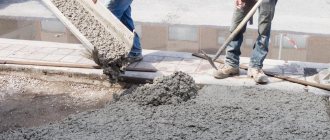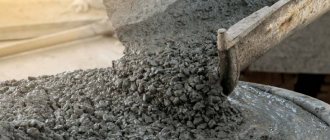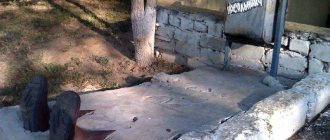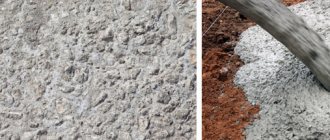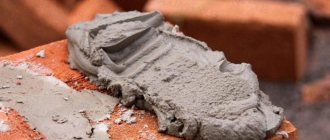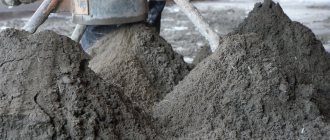Concrete grade M200 corresponds to class B15. This is the first variety to be used in basic construction work. Lower classes are used only during preparation or on objects that do not bear large or even medium loads.
Concrete M200 (B15) is popular among private builders. This is due to the low price, fairly high strength and the ability to prepare concrete yourself. But before buying, you need to understand what kind of work this concrete is suitable for. Where this brand and class is used, what its characteristics, advantages and disadvantages are, you will learn from our article.
Properties and characteristics
Concrete M200 acquires its technical characteristics approximately a month after pouring. During this time, the water in it evaporates, and the sand-cement components acquire good communication with each other.
The main characteristic is the strength of concrete. According to the new classification GOST 26633, concrete M200 corresponds to strength class B15. The number 15 means that a cubic sample of this material must withstand a load of 15 MPa. In the old marking, the M200 value indicated the average compressive strength compared to the class. In other words, when a load of 200 kg/cm² is applied to concrete, it remains intact.
Below is a table with the main properties of concrete M200 class B15. However, it is worth considering that these properties may change their values depending on the type of filler used, the brand of Portland cement or the use of special additives.
| Property | Meaning |
| Mobility (workability) | P2-P4 (cone draft 5-20 cm) |
| Frost resistance | F100 for interior work, F200 for exterior structures |
| Waterproof | W4-W6 |
| Density | 1600-2400 kg/m3 |
| Hardening time | 1 month, at 20-25℃ |
| Specific gravity | 1.6-2.4 tons/m3 |
The density of M200 concrete with a value of 2200 kg/m3 classifies it as a heavy class, but when using fine crushed stone, the value of this property decreases and the concrete is considered fine-grained.
Minuses
Brand M has at least 200 negative qualities. Basically this is a low waterproof rating. The proportions of added water must be observed with particular precision. Of the total composition, its weight is 20%.
According to GOST documentation and the quality certificate, heavy class B 15 M 200 concrete should not be used for houses that will exceed more than 5 floors. Also, the weight of the finished building is not taken into account.
Concrete M 200 BST V 15 P 3- P 4 F100 W 4, although it is considered a low-grade mortar, this does not make it any less in demand. The mixture has good strength properties for laying load-bearing walls, pouring monolithic foundations, floors and paths. It is easy to work with such building materials, because during production all standards and rules for the components were strictly observed. Good strength and durability of the finished elements, plus a reasonable price - these are the main advantages over other brands.
Composition of concrete grade M200
The composition of concrete B15 M200 includes classic components: cement grade M400 or M500, dry sand and aggregate in the form of crushed stone or gravel. All components are mixed with water.
When purchasing cement, you should pay attention to the date of its manufacture. The shelf life of cement is 2-3 months. If the storage time of cement is longer than the period indicated on the packaging, then it is advisable not to use it, since during long-term storage it loses its strength characteristics.
The sand must be free of debris and free of impurities. The size of the sand fraction should not exceed 3.5 mm, since the plasticity of the future mixture directly depends on it. The content of sand with a grain size of 10 mm should not exceed 5%, and sand with a grain diameter of 5 mm should not exceed 15%.
Cuboid crushed stone increases the density of M200 concrete
The size of the crushed stone or gravel fraction should be in the range from 1 to 6 cm and have a cubic shape. The use of such crushed stone reduces the presence of voids. If it is not possible to find crushed stone of the desired shape, then you can use needle-shaped and plate-shaped grains. Such deviations are called crushed stone flakiness. According to GOST 8267-93, its value should not exceed 10-50%. The lower the content of the flange, the lower the cement consumption per 1 m3.
Various plasticizers can be added to the mixture. Thanks to them, it is possible to improve frost resistance and water permeability.
M200 concrete proportions
For large-scale construction, M200 concrete is most often ordered from a factory that will produce the material with the required characteristics and in accordance with GOST 26633-2012. However, when creating concrete structures in private construction, M200 mortar can be made independently.
Let's consider the proportions required to produce 1 cube of M200 concrete using M400 cement (the old abbreviation for cement 32.5). The composition of M200 concrete per 1 m3 will be as follows:
- 1 part cement;
- 2.8 parts sand;
- 4.8 parts crushed stone or gravel;
- 0.2 parts water.
Thus, the ratio of cement and sand-gravel mixture is 1:8. The table below shows a comparative description of the proportions when using different brands of cement.
| Cement brand | Cement (weight ratio, kg/volume, l) | Crushed stone (weight ratio, kg/volume, l) | Sand (weight ratio, kg/volume, l) | Water (parts) |
| M400 | 1 / 10 | 4,8 /42 | 2,8 / 25 | 0.2-0.4 parts |
| M500 | 1 / 10 | 5,6 / 49 | 3,5 / 32 | 0.2-0.4 parts |
Having mixed the specified components in the required proportions, the developer receives ready-mixed concrete M200 B15.
Proportions in buckets
Let's consider another method of making a cubic meter of concrete, in which buckets act as a measuring unit. In this case, to determine the proportions, you need to know the density of its main components and the average weight of cement. The average density of crushed stone is 1500 kg/m3, sand - 1600 kg/m3, and cement 1300 kg/m3. In this case, the weight of cement per 1 cubic meter of concrete is approximately 260 kg. Data taken from GOST.
To determine the required number of buckets, you need to divide the weight of each component in parts by the number of kilograms that can fit in the bucket.
Let's consider how many buckets of each component are needed to make 1 cube of M200 concrete using M400 cement (see the number of parts in the table above). To do this, divide the weight of each component in 1 m3 by its weight in a 10-liter bucket and find out the consumption of materials for preparing 1 m3 of M200 concrete. It turns out:
- 260 × 1 / 1300 × 0.01 (bucket volume) = 20 buckets of cement;
- 260 × 4.8 / 1500 × 0.01 (bucket volume) = 83 buckets of crushed stone;
- 260 × 2.8 / 1600 × 0.01 (bucket volume) = 45 buckets of sand.
When mixing the solution using any of the methods discussed, the volume of water should be 20%. The number of buckets may vary slightly. When using buckets with a volume of 12 liters and above, in the above formulas the figure 0.01 must be replaced by the value 0.012.
Recommendations for filling
It is better to install the container with the prepared solution immediately next to the pouring site. Concrete hardens quickly, and it is not worth spending extra time on transportation.
The mixture is poured from a height of no more than a meter, otherwise there is a risk of it delaminating. The mass is poured through a chute, which increases the accuracy of the work performed.
The surface is leveled with special mops or graters. They try to pour out the entire mass in one go. The places where the fittings are installed are tapped well.
Important! Concreting work is carried out at temperatures from +5 degrees, although the introduction of special additives will expand the temperature range.
In rainy weather, cover the filled base with film, in hot weather, sprinkle it with water, in cold weather, cover it with a felt to prevent the moisture from freezing. Compliance with such rules will allow you to obtain high-quality concrete structures, reduce the risk of cracking and increase the service life of products.
Preparation
To obtain high-quality material, all components must be thoroughly mixed. Any metal trough or concrete mixer is suitable for this. Since buying a concrete mixer is expensive, for large volumes of work, you can rent it at your place of residence.
When mixing the solution in a trough, sand and cement must be thoroughly mixed together until a gray homogeneous mass is obtained. After this, water is added in a small amount to soften the composition and the solution is mixed well again. At the next step, filler in the form of crushed stone or gravel is added to the mixture and the required amount of water is added. The resulting mixture is stirred again until a homogeneous mass is obtained.
Preparing concrete on site using a concrete mixer
If you have a concrete mixer, then the recipe for mixing the solution will be as follows:
- Just a little water is poured into the concrete mixer (to moisten the walls) and turned on;
- add cement and mix with water to obtain cement laitance;
- add sand in the required quantity;
- After about 3-5 minutes crushed stone is added.
On average, the mixing time is 10 minutes, after which the solution is ready. As this value increases, the solution may begin to dry out. Measuring buckets for water and cement should be different. When mixing the solution, it is important to correctly determine the amount of water. It is better to add it in portions, then the chance of obtaining concrete with the desired properties is much higher.
The concrete mixture cannot be left for a long time; it must be poured at one time. Otherwise, the solution will begin to harden, delaminate, and the monolithic structure will be damaged. If everything is done correctly, the resulting structure will be highly reliable and can be used in various construction fields.
Conclusion
Two hundred mortar, corresponding to class B15, is popular in the construction industry. It has the necessary strength margin, is resistant to moisture and can be used in cold climates. It is advisable to buy it at specialized enterprises where high-quality materials are used, technology is followed and laboratory control is available. If necessary, it is easy to prepare the mixture yourself using a concrete mixer. This will reduce costs and, when using quality raw materials, guarantee the characteristics of the mixture.
Application area
Due to its properties and technical characteristics, the M200 concrete grade has found wide application in construction. With its help, problems of varying levels of complexity are solved, because it is distinguished not only by good quality, but also by an affordable price.
Manufactured concrete M200 with strength class B15 is very often used as a foundation for houses, monolithic walls, ceilings, flights of stairs or reinforced concrete structures. Other areas of application include:
- creation of concrete paths;
- concreting roadside slopes, curbs and embankment fences;
- creation of concrete screed in open areas and indoors;
- construction of load-bearing walls or production of floors;
- production of concrete rings for wells for various purposes or fences;
- production of road slabs using special additives;
- concrete repair and strengthening of building structures.
Do not forget that it is better not to use M200 concrete for buildings and structures subject to high loads.
When determining the area of destination of the material, it is worth taking into account the crushed stone fractions. Fractions of small diameter are used in small formworks, since the solution in this case spreads smoothly throughout the entire form and allows you to obtain small structures. The coarse-grained fractions of crushed stone in concrete allow it to be used in the creation of strip foundations and reinforced concrete structures.
Outdoor side table made of concrete
Advantages
- The mortar is universal and therefore it is often used by both private builders and industrial facilities, due to the maximum ratio of mechanical properties, reasonable cost and quality.
- If we compare the expanded clay concrete mixture M 200 with similar low-class compositions, it comes with high calculated compressive resistance data.
- High frost resistance characteristics.
- The low thermal conductivity of the building material allows you to retain heat inside a room made of reinforced concrete without installing an additional thermal insulation layer.
- A mixture with this marking quickly becomes strong and dense, this will allow you to carry out repair and construction work with maximum speed.
- The formation of cracks during construction is reduced to zero.
- The working temperature of the solution is from +5 to +350 degrees. The addition of frost-resistant agents in certain proportions is used at subzero temperatures.
Advantages
A distinctive advantage is versatility. Concrete M200 can be used both for a private home, for the construction of outbuildings, and on a large industrial scale. Compared to other brands, it has other advantages:
- affordable price with high strength indicators;
- has good adhesion to reinforcement;
- low thermal conductivity reduces the cost of thermal insulation materials;
- ease of manufacturing and pouring;
- quickly acquires the declared strength.
Where do you use concrete and what difficulties do you encounter when making it? We invite you to discuss this in the comments and share your experience.
Reviews
We were busy arranging a children's playground at the dacha and decided to make a small play area in the form of a gazebo. M200 concrete was used to fill the floor and foundation of the gazebo. We chose this particular brand because we read a lot of positive reviews about it, and this concrete was just right for the price. In addition, it is perfect for these purposes.
Andrey
We were building a house and the foreman recommended using M200 concrete almost everywhere. His scope of activity is wide, suitable for almost everything that was made of concrete.
Sergey
About 5 years ago, a summer kitchen .
The foundation was laid using this concrete. The workers did everything conscientiously and the foundation still stands without a single crack. Eugene
Calculation of the amount of solution
The foundation of any structure is divided into sections that have geometric dimensions to calculate the volume. The cubic capacity of disparate elements is added up and the total volume is obtained.
For concreting 15.2 m³ (strip foundation) 9.5 parts of components are required (1: 3: 5: 0.5). Divide 15.2 / 9.5 = 1.6 m³, where:
- cement - 1 part = 1.6 m3 x 1.6 (volume weight of cement) = 2.56 t (52 bags of 50 kg or 103 bags of 25 kg);
- sand - 3 parts = 1.6 m3 x 3 x 1.5 (volumetric weight of sand) = 7.2 tons, you can order KAMAZ
- crushed stone - 5 parts = 1.6 m3 5 x 2.1 (volumetric weight of crushed stone) = 16.8 t (buy in bulk).
Each specific option is calculated, taking into account the location of the structure. The foundation is designed so that there are fewer shear and bending loads, and only compression or tension acts. Concrete works more efficiently for such efforts.

